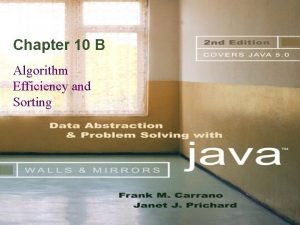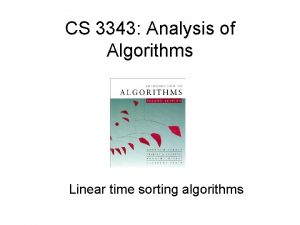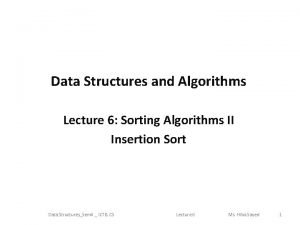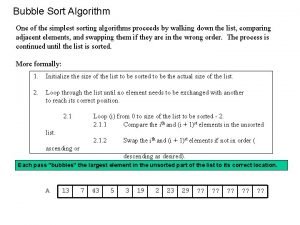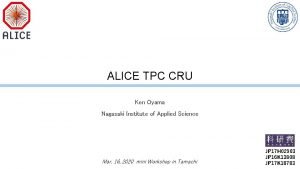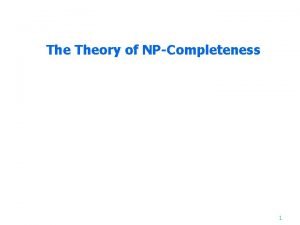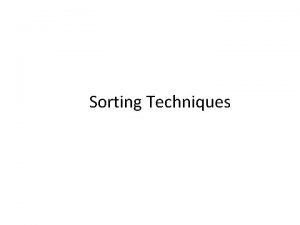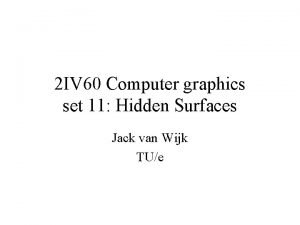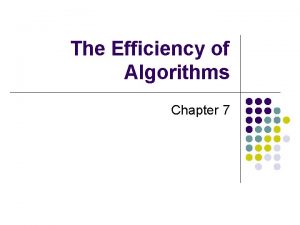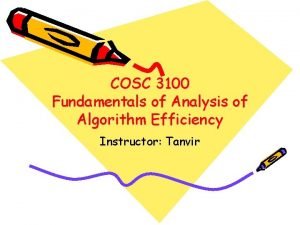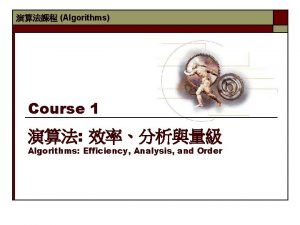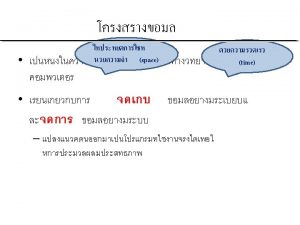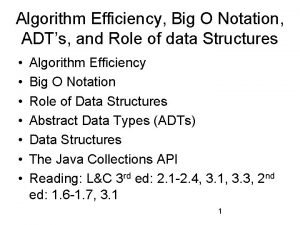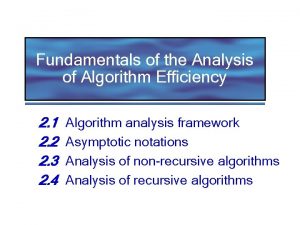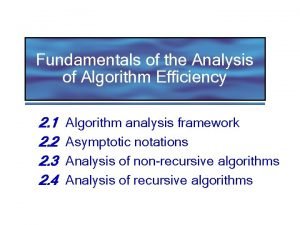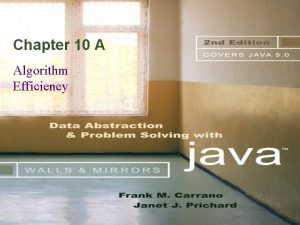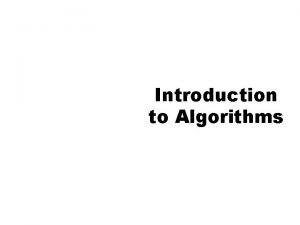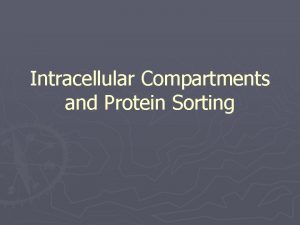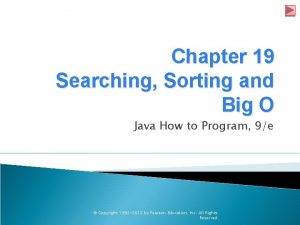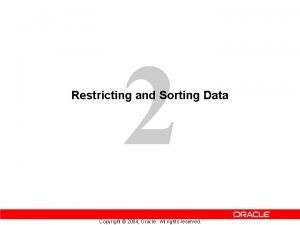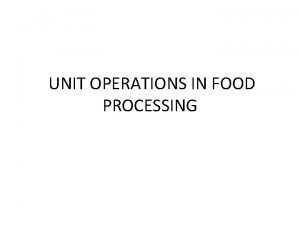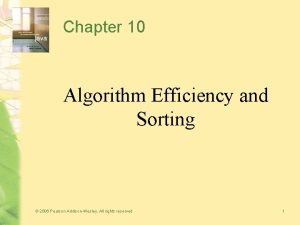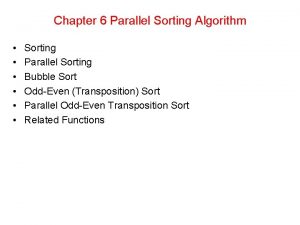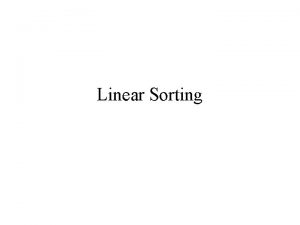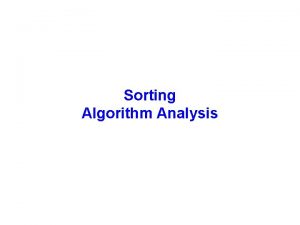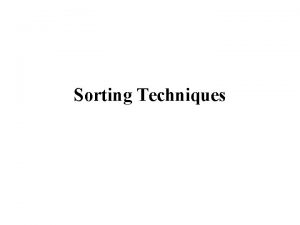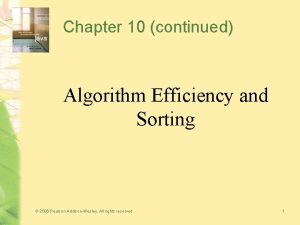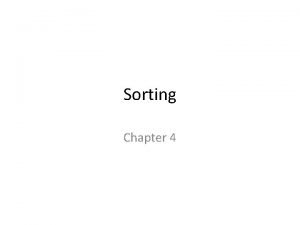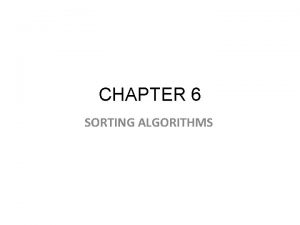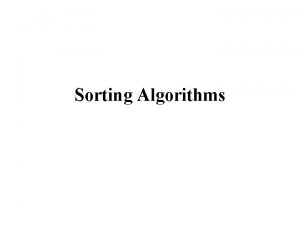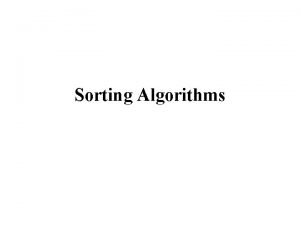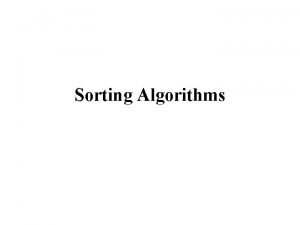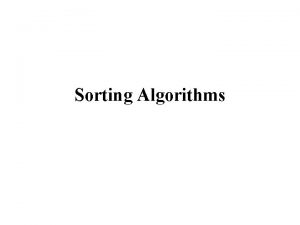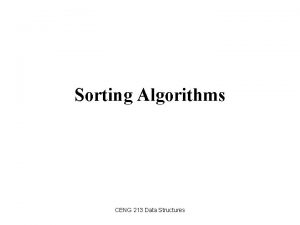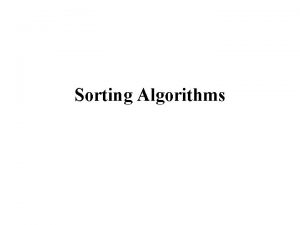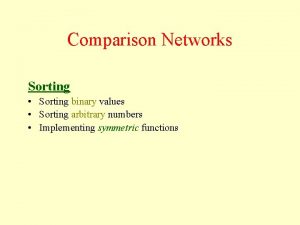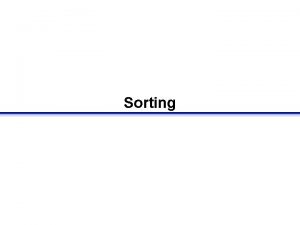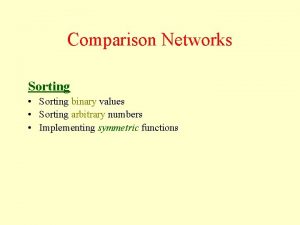Chapter 10 Algorithm Efficiency and Sorting 2006 Pearson








































- Slides: 40

Chapter 10 Algorithm Efficiency and Sorting © 2006 Pearson Addison-Wesley. All rights reserved 1

Measuring the Efficiency of Algorithms • Analysis of algorithms – Provides tools for contrasting the efficiency of different methods of solution • A comparison of algorithms – Should focus of significant differences in efficiency – Should not consider reductions in computing costs due to clever coding tricks © 2006 Pearson Addison-Wesley. All rights reserved 2

Measuring the Efficiency of Algorithms • Three difficulties with comparing programs instead of algorithms – How are the algorithms coded? – What computer should you use? – What data should the programs use? • Algorithm analysis should be independent of – Specific implementations – Computers – Data © 2006 Pearson Addison-Wesley. All rights reserved 3

The Execution Time of Algorithms • Counting an algorithm's operations is a way to access its efficiency – An algorithm’s execution time is related to the number of operations it requires – Examples • Traversal of a linked list • The Towers of Hanoi • Nested Loops © 2006 Pearson Addison-Wesley. All rights reserved 4

Algorithm Growth Rates • An algorithm’s time requirements can be measured as a function of the problem size • An algorithm’s growth rate – Enables the comparison of one algorithm with another – Examples Algorithm A requires time proportional to n 2 Algorithm B requires time proportional to n • Algorithm efficiency is typically a concern for large problems only © 2006 Pearson Addison-Wesley. All rights reserved 5

Algorithm Growth Rates Figure 10 -1 Time requirements as a function of the problem size n © 2006 Pearson Addison-Wesley. All rights reserved 6

Order-of-Magnitude Analysis and Big O Notation • Definition of the order of an algorithm A is order f(n) – denoted O(f(n)) – if constants k and n 0 exist such that A requires no more than k * f(n) time units to solve a problem of size n ≥ n 0 • Growth-rate function – A mathematical function used to specify an algorithm’s order in terms of the size of the problem • Big O notation – A notation that uses the capital letter O to specify an algorithm’s order – Example: O(f(n)) © 2006 Pearson Addison-Wesley. All rights reserved 7

Order-of-Magnitude Analysis and Big O Notation Figure 10 -3 a A comparison of growth-rate functions: a) in tabular form © 2006 Pearson Addison-Wesley. All rights reserved 8

Order-of-Magnitude Analysis and Big O Notation Figure 10 -3 b A comparison of growth-rate functions: b) in graphical form © 2006 Pearson Addison-Wesley. All rights reserved 9

Order-of-Magnitude Analysis and Big O Notation • Order of growth of some common functions O(1) < O(log 2 n) < O(n * log 2 n) < O(n 2) < O(n 3) < O(2 n) • Properties of growth-rate functions – You can ignore low-order terms – You can ignore a multiplicative constant in the highorder term – O(f(n)) + O(g(n)) = O(f(n) + g(n)) © 2006 Pearson Addison-Wesley. All rights reserved 10

Order-of-Magnitude Analysis and Big O Notation • Worst-case and average-case analyses – An algorithm can require different times to solve different problems of the same size • Worst-case analysis – A determination of the maximum amount of time that an algorithm requires to solve problems of size n • Average-case analysis – A determination of the average amount of time that an algorithm requires to solve problems of size n © 2006 Pearson Addison-Wesley. All rights reserved 11

Keeping Your Perspective • Throughout the course of an analysis, keep in mind that you are interested only in significant differences in efficiency • When choosing an ADT’s implementation, consider how frequently particular ADT operations occur in a given application • Some seldom-used but critical operations must be efficient © 2006 Pearson Addison-Wesley. All rights reserved 12

Keeping Your Perspective • If the problem size is always small, you can probably ignore an algorithm’s efficiency • Weigh the trade-offs between an algorithm’s time requirements and its memory requirements • Compare algorithms for both style and efficiency • Order-of-magnitude analysis focuses on large problems © 2006 Pearson Addison-Wesley. All rights reserved 13

The Efficiency of Searching Algorithms • Sequential search – Strategy • Look at each item in the data collection in turn, beginning with the first one • Stop when – You find the desired item – You reach the end of the data collection © 2006 Pearson Addison-Wesley. All rights reserved 14

The Efficiency of Searching Algorithms • Sequential search – Efficiency • Worst case: O(n) • Average case: O(n) • Best case: O(1) © 2006 Pearson Addison-Wesley. All rights reserved 15

The Efficiency of Searching Algorithms • Binary search – Strategy • To search a sorted array for a particular item – Repeatedly divide the array in half – Determine which half the item must be in, if it is indeed present, and discard the other half – Efficiency • Worst case: O(log 2 n) • For large arrays, the binary search has an enormous advantage over a sequential search © 2006 Pearson Addison-Wesley. All rights reserved 16

Sorting Algorithms and Their Efficiency • Sorting – A process that organizes a collection of data into either ascending or descending order • Categories of sorting algorithms – An internal sort • Requires that the collection of data fit entirely in the computer’s main memory – An external sort • The collection of data will not fit in the computer’s main memory all at once but must reside in secondary storage © 2006 Pearson Addison-Wesley. All rights reserved 17

Sorting Algorithms and Their Efficiency • Data items to be sorted can be – Integers – Character strings – Objects • Sort key – The part of a record that determines the sorted order of the entire record within a collection of records © 2006 Pearson Addison-Wesley. All rights reserved 18

Selection Sort • Selection sort – Strategy • Select the largest item and put it in its correct place • Select the next largest item and put it in its correct place, etc. Figure 10 -4 A selection sort of an array of five integers © 2006 Pearson Addison-Wesley. All rights reserved 19

Selection Sort • Analysis – Selection sort is O(n 2) • Advantage of selection sort – It does not depend on the initial arrangement of the data • Disadvantage of selection sort – It is only appropriate for small n © 2006 Pearson Addison-Wesley. All rights reserved 20

Bubble Sort • Bubble sort – Strategy • Compare adjacent elements and exchange them if they are out of order – Comparing the first two elements, the second and third elements, and so on, will move the largest (or smallest) elements to the end of the array – Repeating this process will eventually sort the array into ascending (or descending) order © 2006 Pearson Addison-Wesley. All rights reserved 21

Bubble Sort Figure 10 -5 The first two passes of a bubble sort of an array of five integers: a) pass 1; b) pass 2 © 2006 Pearson Addison-Wesley. All rights reserved 22

Bubble Sort • Analysis – Worst case: O(n 2) – Best case: O(n) © 2006 Pearson Addison-Wesley. All rights reserved 23

Insertion Sort • Insertion sort – Strategy • Partition the array into two regions: sorted and unsorted • Take each item from the unsorted region and insert it into its correct order in the sorted region Figure 10 -6 An insertion sort partitions the array into two regions © 2006 Pearson Addison-Wesley. All rights reserved 24

Insertion Sort Figure 10 -7 An insertion sort of an array of five integers. © 2006 Pearson Addison-Wesley. All rights reserved 25

Insertion Sort • Analysis – Worst case: O(n 2) – For small arrays • Insertion sort is appropriate due to its simplicity – For large arrays • Insertion sort is prohibitively inefficient © 2006 Pearson Addison-Wesley. All rights reserved 26

Mergesort • Important divide-and-conquer sorting algorithms – Mergesort – Quicksort • Mergesort – A recursive sorting algorithm – Gives the same performance, regardless of the initial order of the array items – Strategy • Divide an array into halves • Sort each half • Merge the sorted halves into one sorted array © 2006 Pearson Addison-Wesley. All rights reserved 27

Mergesort Figure 10 -8 A mergesort with an auxiliary temporary array © 2006 Pearson Addison-Wesley. All rights reserved 28

Mergesort Figure 10 -9 A mergesort of an array of six integers © 2006 Pearson Addison-Wesley. All rights reserved 29

Mergesort • Analysis – Worst case: O(n * log 2 n) – Average case: O(n * log 2 n) – Advantage • It is an extremely efficient algorithm with respect to time – Drawback • It requires a second array as large as the original array © 2006 Pearson Addison-Wesley. All rights reserved 30

Quicksort • Quicksort – A divide-and-conquer algorithm – Strategy • Partition an array into items that are less than the pivot and those that are greater than or equal to the pivot • Sort the left section • Sort the right section Figure 10 -12 A partition about a pivot © 2006 Pearson Addison-Wesley. All rights reserved 31

Quicksort • Using an invariant to develop a partition algorithm – Invariant for the partition algorithm The items in region S 1 are all less than the pivot, and those in S 2 are all greater than or equal to the pivot Figure 10 -14 Invariant for the partition algorithm © 2006 Pearson Addison-Wesley. All rights reserved 32

Quicksort • Analysis – Worst case • quicksort is O(n 2) when the array is already sorted and the smallest item is chosen as the pivot Figure 10 -19 A worst-case partitioning with quicksort © 2006 Pearson Addison-Wesley. All rights reserved 33

Quicksort • Analysis – Average case • quicksort is O(n * log 2 n) when S 1 and S 2 contain the same – or nearly the same – number of items arranged at random Figure 10 -20 A average-case partitioning with quicksort © 2006 Pearson Addison-Wesley. All rights reserved 34

Quicksort • Analysis – quicksort is usually extremely fast in practice – Even if the worst case occurs, quicksort’s performance is acceptable for moderately large arrays © 2006 Pearson Addison-Wesley. All rights reserved 35

Radix Sort • Radix sort – Treats each data element as a character string – Strategy • Repeatedly organize the data into groups according to the ith character in each element • Analysis – Radix sort is O(n) © 2006 Pearson Addison-Wesley. All rights reserved 36

Radix Sort Figure 10 -21 A radix sort of eight integers © 2006 Pearson Addison-Wesley. All rights reserved 37

A Comparison of Sorting Algorithms Figure 10 -22 Approximate growth rates of time required for eight sorting algorithms © 2006 Pearson Addison-Wesley. All rights reserved 38

Summary • Order-of-magnitude analysis and Big O notation measure an algorithm’s time requirement as a function of the problem size by using a growthrate function • To compare the inherit efficiency of algorithms – Examine their growth-rate functions when the problems are large – Consider only significant differences in growth-rate functions © 2006 Pearson Addison-Wesley. All rights reserved 39

Summary • Worst-case and average-case analyses – Worst-case analysis considers the maximum amount of work an algorithm requires on a problem of a given size – Average-case analysis considers the expected amount of work an algorithm requires on a problem of a given size • Order-of-magnitude analysis can be used to choose an implementation for an abstract data type • Selection sort, bubble sort, and insertion sort are all O(n 2) algorithms • Quicksort and mergesort are two very efficient sorting algorithms © 2006 Pearson Addison-Wesley. All rights reserved 40
 Difference between external and internal sorting
Difference between external and internal sorting Efficiency of sorting algorithms
Efficiency of sorting algorithms Complexity of algorithm
Complexity of algorithm Productive inefficiency and allocative inefficiency
Productive inefficiency and allocative inefficiency Allocative efficiency vs productive efficiency
Allocative efficiency vs productive efficiency Productively efficient vs allocatively efficient
Productively efficient vs allocatively efficient Stable sorting algorithm
Stable sorting algorithm Sorting algorithm
Sorting algorithm Simplest sort algorithm
Simplest sort algorithm Nagasaki sorting algorithm
Nagasaki sorting algorithm Quick sort iterative
Quick sort iterative Non-deterministic algorithm
Non-deterministic algorithm Non deterministic algorithm for sorting
Non deterministic algorithm for sorting Quicksort
Quicksort Depth sorting method in computer graphics
Depth sorting method in computer graphics Algorithm efficiency
Algorithm efficiency Efficiency class of algorithm
Efficiency class of algorithm Efficiency class algorithm
Efficiency class algorithm Algorithm efficiency
Algorithm efficiency Algorithm efficiency
Algorithm efficiency Steps in mathematical analysis of non recursive algorithm
Steps in mathematical analysis of non recursive algorithm Efficiency analysis of algorithm
Efficiency analysis of algorithm Algorithm efficiency is typically a concern for
Algorithm efficiency is typically a concern for Big theta notation
Big theta notation Pearson education, inc. publishing as prentice hall
Pearson education, inc. publishing as prentice hall Pearson education inc publishing as pearson prentice hall
Pearson education inc publishing as pearson prentice hall Robert whelan
Robert whelan Educational pearson pearson times
Educational pearson pearson times Pearson education inc publishing as pearson prentice hall
Pearson education inc publishing as pearson prentice hall 2012 pearson education inc
2012 pearson education inc Copyright 2008
Copyright 2008 A* algorithm and ao* algorithm
A* algorithm and ao* algorithm Chapter 7 consumers producers and the efficiency of markets
Chapter 7 consumers producers and the efficiency of markets Differentiate between sorting and grading
Differentiate between sorting and grading Intracellular compartments and protein sorting
Intracellular compartments and protein sorting Compare between bubble sort and selection sort.
Compare between bubble sort and selection sort. Searching and sorting arrays in c++
Searching and sorting arrays in c++ Big o java
Big o java Orale charakterstruktur
Orale charakterstruktur Sorting and grading in food processing
Sorting and grading in food processing Sort meaning
Sort meaning

